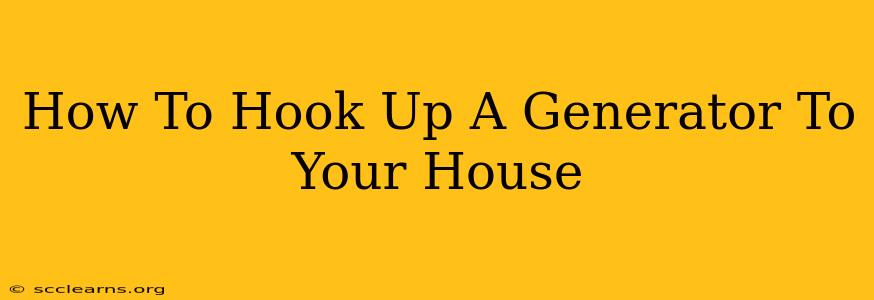Power outages can be disruptive, inconvenient, and even dangerous. Having a generator on hand can provide peace of mind and keep essential systems running during emergencies. But connecting a generator to your home's electrical system isn't a DIY project to be taken lightly. This comprehensive guide will walk you through the process, highlighting crucial safety measures and best practices. Improper installation can lead to serious injury or even death, so if you're not comfortable with electrical work, hiring a qualified electrician is strongly recommended.
Understanding Generator Types and Connections
Before diving into the installation process, it's crucial to understand the different types of generators and their connection methods. There are two primary types:
1. Portable Generators:
These are smaller, less powerful generators ideal for powering a few essential appliances. They typically connect via a manual transfer switch or, less safely, using extension cords directly to specific appliances. Using extension cords is strongly discouraged due to the significant safety risks involved.
2. Standby Generators:
These are larger, more powerful generators that automatically start when the power goes out. They require a permanent, hardwired connection to your home's electrical panel via an interlock system and a transfer switch. This is the safest and most reliable method for whole-house power during outages.
Essential Safety Precautions:
Safety is paramount when working with electricity and generators. Always follow these guidelines:
- Turn off the generator's circuit breaker before performing any maintenance or adjustments.
- Never operate a generator indoors or in enclosed spaces. Generator exhaust contains carbon monoxide, a deadly gas.
- Ensure proper ventilation around the generator to prevent overheating.
- Keep children and pets away from the generator.
- Use appropriate safety equipment, including gloves and eye protection.
- Consult your local electrical codes and regulations before installation.
- Never overload the generator. Exceeding its capacity can damage the generator and pose a fire hazard.
- Use a qualified electrician. This is particularly crucial when hardwiring a standby generator to your home's electrical panel.
Step-by-Step Guide to Connecting a Generator (Standby Generator):
This section outlines the process for connecting a standby generator, which offers the safest and most reliable power solution. Remember, this is a complex process best handled by a professional electrician.
-
Professional Installation: The most crucial step is hiring a licensed electrician experienced in generator installations. They will ensure compliance with local codes and safety regulations.
-
Transfer Switch Installation: A transfer switch is essential to safely switch power between your utility company and your generator. Your electrician will install this switch, usually in your electrical panel.
-
Wiring the Generator: The electrician will connect the generator to the transfer switch using heavy-gauge wiring that meets code requirements. This connection ensures a safe and reliable power supply during outages.
-
Interlock System: An interlock system is vital to prevent accidental backfeeding of power into the grid, which could harm utility workers. Your electrician will ensure this system is correctly installed.
-
Testing and Inspection: After installation, thorough testing and inspection are vital to ensure the generator and all connections are functioning correctly and safely.
Connecting a Portable Generator (Temporary Power):
Connecting a portable generator is a simpler process, but still requires caution. The safest method is using a manual transfer switch:
-
Manual Transfer Switch: Install a manual transfer switch to isolate the circuits you want to power from your home's main panel.
-
Connect the Generator: Connect the generator's output to the input of the transfer switch following manufacturer instructions.
-
Power Circuits: Switch the transfer switch to the "generator" position to provide power to the selected circuits.
-
Safety First: Never connect a portable generator directly to your home's electrical panel.
Conclusion:
Connecting a generator to your house is a critical safety and power reliability undertaking. While portable generators offer a temporary solution, a standby generator, professionally installed, offers superior safety and convenience. Always prioritize safety and consider hiring a qualified electrician to ensure the proper and safe installation of your generator. Remember, preventing accidents is the best strategy; always exercise caution when dealing with electricity.

